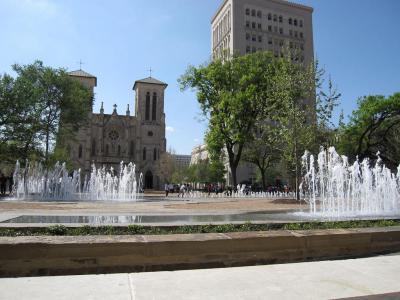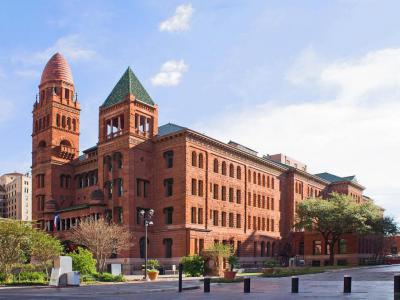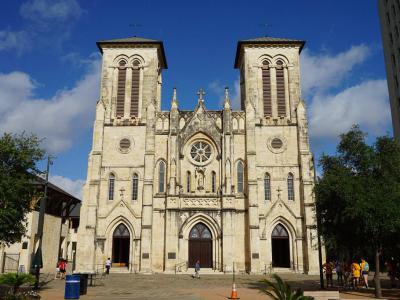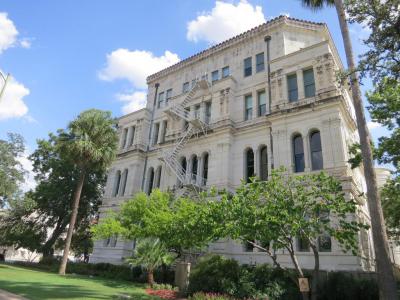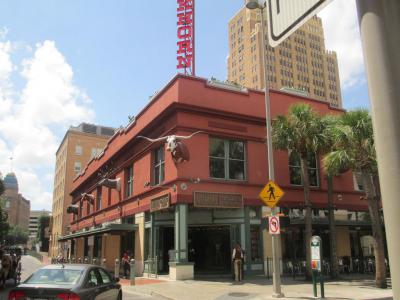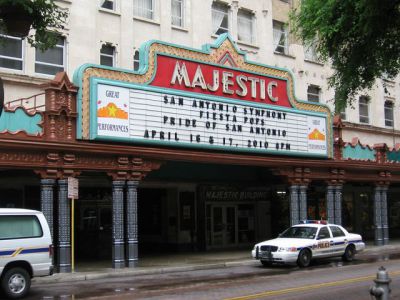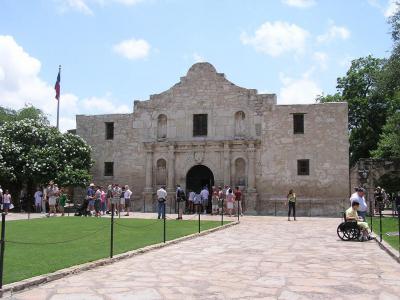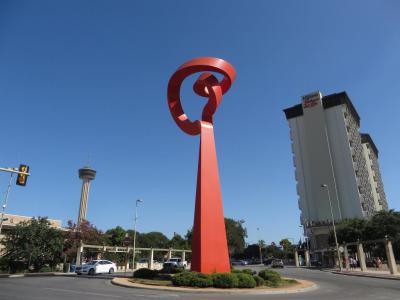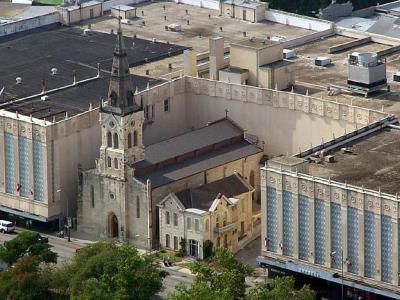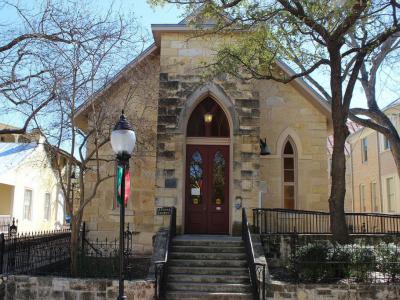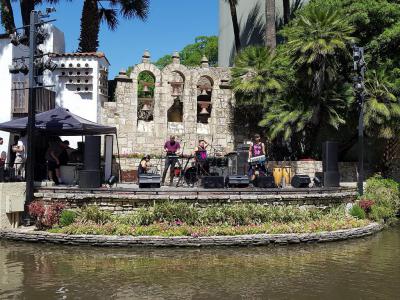
San Antonio Introduction Walking Tour (Self Guided), San Antonio
San Antonio, one of Texas' major cities, boasts rich colonial heritage. The city was named by a 1691 Spanish expedition for Saint Anthony of Padua, whose feast day is June 13. At the time of European encounter, the area near the San Antonio River Valley was inhabited by Payaya Indians who called it Yanaguana, the "refreshing waters".
In 1709, Spanish Father Antonio de Olivares visited the site, and was determined to found a mission and civilian settlement there. Eventually, this paved the way for the Spanish-Mexican settlement of Southwestern lands. At some point, San Antonio grew to become the largest Spanish settlement in Texas, and was designated as the capital of the Spanish, later Mexican, province of Tejas. Mexico allowed European-American settlers from the United States into the territory, who then mostly occupied the land in the eastern part. Following the unilateral abolition of the Mexican Constitution of 1824, violence ensued in many states of Mexico.
In a series of battles, the Texian Army succeeded in forcing Mexican soldiers out of the settlement areas east of San Antonio, which were dominated by Americans. In December 1835, Texian forces captured San Antonio. In 1845, the United States finally decided to annex Texas and include it as a state in the Union. This led to the Mexican–American War, which the U.S. ultimately won, but it proved devastating to San Antonio – its population reduced by almost two-thirds, towards just 800 people.
Following the Civil War, San Antonio prospered as a center of the cattle industry, and remained a frontier city, with a mixture of cultures different from other U.S. cities. One profound impact on the city came from the German immigrants. In 1877, following the Reconstruction Era, developers constructed the first railroad to San Antonio, connecting it to major markets and port cities. At the beginning of the 20th century, the streets of the city's downtown were widened to accommodate street cars and modern traffic.
Today's San Antonio is a home to numerous attractions visited annually by almost 32 million tourists. Among them, most notably, are the Alamo, an 18th-century Spanish mission, currently a museum dedicated to 1836 battle for Texan independence from Mexico, and San Antonio's River Walk – a miles-long pedestrian promenade lined with cafes and shops. To explore these and other prominent sights of San Antonio, follow this self-guided introduction walk.
In 1709, Spanish Father Antonio de Olivares visited the site, and was determined to found a mission and civilian settlement there. Eventually, this paved the way for the Spanish-Mexican settlement of Southwestern lands. At some point, San Antonio grew to become the largest Spanish settlement in Texas, and was designated as the capital of the Spanish, later Mexican, province of Tejas. Mexico allowed European-American settlers from the United States into the territory, who then mostly occupied the land in the eastern part. Following the unilateral abolition of the Mexican Constitution of 1824, violence ensued in many states of Mexico.
In a series of battles, the Texian Army succeeded in forcing Mexican soldiers out of the settlement areas east of San Antonio, which were dominated by Americans. In December 1835, Texian forces captured San Antonio. In 1845, the United States finally decided to annex Texas and include it as a state in the Union. This led to the Mexican–American War, which the U.S. ultimately won, but it proved devastating to San Antonio – its population reduced by almost two-thirds, towards just 800 people.
Following the Civil War, San Antonio prospered as a center of the cattle industry, and remained a frontier city, with a mixture of cultures different from other U.S. cities. One profound impact on the city came from the German immigrants. In 1877, following the Reconstruction Era, developers constructed the first railroad to San Antonio, connecting it to major markets and port cities. At the beginning of the 20th century, the streets of the city's downtown were widened to accommodate street cars and modern traffic.
Today's San Antonio is a home to numerous attractions visited annually by almost 32 million tourists. Among them, most notably, are the Alamo, an 18th-century Spanish mission, currently a museum dedicated to 1836 battle for Texan independence from Mexico, and San Antonio's River Walk – a miles-long pedestrian promenade lined with cafes and shops. To explore these and other prominent sights of San Antonio, follow this self-guided introduction walk.
How it works: Download the app "GPSmyCity: Walks in 1K+ Cities" from Apple App Store or Google Play Store to your mobile phone or tablet. The app turns your mobile device into a personal tour guide and its built-in GPS navigation functions guide you from one tour stop to next. The app works offline, so no data plan is needed when traveling abroad.
San Antonio Introduction Walking Tour Map
Guide Name: San Antonio Introduction Walking Tour
Guide Location: USA » San Antonio (See other walking tours in San Antonio)
Guide Type: Self-guided Walking Tour (Sightseeing)
# of Attractions: 14
Tour Duration: 2 Hour(s)
Travel Distance: 3.3 Km or 2.1 Miles
Author: Paulina
Sight(s) Featured in This Guide:
Guide Location: USA » San Antonio (See other walking tours in San Antonio)
Guide Type: Self-guided Walking Tour (Sightseeing)
# of Attractions: 14
Tour Duration: 2 Hour(s)
Travel Distance: 3.3 Km or 2.1 Miles
Author: Paulina
Sight(s) Featured in This Guide:
- Main Plaza
- Bexar County Courthouse
- Cathedral of San Fernando
- City Hall
- Spanish Governor's Palace
- Market Square (El Mercado)
- Buckhorn Saloon & Museum. Texas Ranger Museum
- Majestic Theatre
- Alamo
- Menger Hotel
- Torch of Friendship
- St. Joseph Catholic Church
- Little Church of La Villita
- Arneson River Theater
1) Main Plaza
As one of the only surviving Spanish colonial plazas in the nation, Main Plaza has been a part of downtown San Antonio since the early 18th century. New World Spanish urban planners created a lively community here by connecting the city's cathedral with "Plaza de las Islas," as the area was originally named.
Five new interactive fountains are located in the center of the plaza, helping create a serene and cool atmosphere — and a fun place for kids to play. Free wi-fi has been added, as well as abundant seating in shaded areas.
Small vignettes of San Antonio's history are scattered throughout the plaza in 30 artistic pavers, each telling a historically accurate story about the plaza through quotes and drawings by Char Miller. With the Lady Justice Fountain, dating back to 1896, and San Fernando Cathedral, which is the oldest continuously operated cathedral in the nation and the oldest building in Texas, it becomes evident that Main Plaza embodies San Antonio's rich history.
Local culture unfolds in Main Plaza every day, from musicians performing and artists displaying their works, to farmers selling produce. The vivid history, accompanied by the local culture and Spanish influences, shows that Main Plaza is truly the "cultural corazón of the city."
Five new interactive fountains are located in the center of the plaza, helping create a serene and cool atmosphere — and a fun place for kids to play. Free wi-fi has been added, as well as abundant seating in shaded areas.
Small vignettes of San Antonio's history are scattered throughout the plaza in 30 artistic pavers, each telling a historically accurate story about the plaza through quotes and drawings by Char Miller. With the Lady Justice Fountain, dating back to 1896, and San Fernando Cathedral, which is the oldest continuously operated cathedral in the nation and the oldest building in Texas, it becomes evident that Main Plaza embodies San Antonio's rich history.
Local culture unfolds in Main Plaza every day, from musicians performing and artists displaying their works, to farmers selling produce. The vivid history, accompanied by the local culture and Spanish influences, shows that Main Plaza is truly the "cultural corazón of the city."
2) Bexar County Courthouse
The Bexar County Courthouse is a historical building in downtown San Antonio, bordering Main Plaza along with such other architectural landmarks as the Cathedral of San Fernando. The building was designed by architect J. Riely Gordon in Romanesque Revival style. Ground for the structure was broken on August 4, 1891 and the cornerstone was laid December 17, 1892.
After several delays, it took the county overall five years and five bond issues to complete the construction in 1897 – producing four stories of native granite, red sandstone, terracotta, beehive dome and towers, and red tile roofs. It then took county business less than 15 years to outgrow it, so by 1914, the courthouse had become “...so crowded that no county officer has sufficient room in which to transact public business and in which the jury rooms for the jurors' accommodations are so lacking in comfort as to make jury service a real hardship."
In 1926, modifications were made resulting in a three-story addition to the south side, as well as an entire remodeling, from the basement up. It was also during this renovation that much of the red tile roof was replaced with the attractive green clay tiles seen today. Still, after only three years, the county officials once again complained about lack of space and needing better facilities, thus prompting further changes to be made over the course of the next 40 years. At one point, District Attorney Hubert Green, Jr. decided he needed some air conditioning for his office, so he used the money from his discretionary fund obtained through nefarious operations, like gambling and drug proceeds, to purchase a small window unit. Snucking it into the non-air conditioned courthouse, he plugged it in and... shorted out the whole building’s electrical system.
Throughout the 1960s-70s, substantial remodeling and modernization included a 24,000-square foot addition to the southwest corner of the courthouse. Performed in stages, the full restoration of the building saw the removal of some previously added elements using the Brokk 250 “robots”. In 1977, the edifice was added to the National Register of Historic Places.
Today restored to its 1926 iteration, the courthouse stands with its structural integrity intact, once again serving Bexar County citizenry as the County Seat through its third century and, gratefully, fully air-conditioned.
After several delays, it took the county overall five years and five bond issues to complete the construction in 1897 – producing four stories of native granite, red sandstone, terracotta, beehive dome and towers, and red tile roofs. It then took county business less than 15 years to outgrow it, so by 1914, the courthouse had become “...so crowded that no county officer has sufficient room in which to transact public business and in which the jury rooms for the jurors' accommodations are so lacking in comfort as to make jury service a real hardship."
In 1926, modifications were made resulting in a three-story addition to the south side, as well as an entire remodeling, from the basement up. It was also during this renovation that much of the red tile roof was replaced with the attractive green clay tiles seen today. Still, after only three years, the county officials once again complained about lack of space and needing better facilities, thus prompting further changes to be made over the course of the next 40 years. At one point, District Attorney Hubert Green, Jr. decided he needed some air conditioning for his office, so he used the money from his discretionary fund obtained through nefarious operations, like gambling and drug proceeds, to purchase a small window unit. Snucking it into the non-air conditioned courthouse, he plugged it in and... shorted out the whole building’s electrical system.
Throughout the 1960s-70s, substantial remodeling and modernization included a 24,000-square foot addition to the southwest corner of the courthouse. Performed in stages, the full restoration of the building saw the removal of some previously added elements using the Brokk 250 “robots”. In 1977, the edifice was added to the National Register of Historic Places.
Today restored to its 1926 iteration, the courthouse stands with its structural integrity intact, once again serving Bexar County citizenry as the County Seat through its third century and, gratefully, fully air-conditioned.
Sight description based on Wikipedia.
3) Cathedral of San Fernando (must see)
The Cathedral of San Fernando in San Antonio is affiliated with the Roman Catholic Church. It is the mother church of the Archdiocese of San Antonio and the seat of its archbishop. The cathedral is also known as the Church of Nuestra Señora de la Candelaria y Guadalupe and is listed on the National Register of Historic Places.
The original church of San Fernando was built between 1738 and 1750. The walls of that church today form the sanctuary of the cathedral, which gives rise to its claim as the oldest cathedral in the State of Texas, much as in the United States. The church was named for Ferdinand III of Castile, who ruled in the 13th century. The baptismal font, believed to be a gift from Charles III, who became King of Spain from 1759, is the oldest piece of liturgical furnishing within the cathedral. The temple itself was built by immigrants from the Canary Islands, for which reason the interior holds a picture of the Virgin of Candelaria, the patroness of the Canary Islands.
In 1868, the cathedral was considerably enlarged in the Gothic style, the addition forming the existing nave. The carved stone Stations of the Cross were added in 1874. The striking stained glass windows were added in 1920. The cathedral remains at the heart of the Catholic religious life of San Antonio, and this includes involvement in annual events, such as the Fiesta Week. In February 2006, the cathedral held a year-long celebration marking San Antonio’s 275th anniversary.
The original church of San Fernando was built between 1738 and 1750. The walls of that church today form the sanctuary of the cathedral, which gives rise to its claim as the oldest cathedral in the State of Texas, much as in the United States. The church was named for Ferdinand III of Castile, who ruled in the 13th century. The baptismal font, believed to be a gift from Charles III, who became King of Spain from 1759, is the oldest piece of liturgical furnishing within the cathedral. The temple itself was built by immigrants from the Canary Islands, for which reason the interior holds a picture of the Virgin of Candelaria, the patroness of the Canary Islands.
In 1868, the cathedral was considerably enlarged in the Gothic style, the addition forming the existing nave. The carved stone Stations of the Cross were added in 1874. The striking stained glass windows were added in 1920. The cathedral remains at the heart of the Catholic religious life of San Antonio, and this includes involvement in annual events, such as the Fiesta Week. In February 2006, the cathedral held a year-long celebration marking San Antonio’s 275th anniversary.
Sight description based on Wikipedia.
4) City Hall
Sitting in the center of Military Plaza (Plaza de Armas), this Italian Renaissance Revival building, established in 1722 by the Spanish settlers of Texas who had earlier set up a garrison at San Pedro Creek which runs along the western border of the plaza, is the city’s first seat of government and one of the oldest public buildings in continuous use in the U.S.
The plaza itself has a long history. Moses Austin came here in 1820 seeking permission from the Spanish governor to settle Anglo-American colonists in Texas. Construction of the City Hall in the center of the plaza largely changed its character and put an end to the open air market, the "Chili Queens" and the rowdy activities of the cowboys, cattlemen and gamblers who used to frequent the area outside the early Old Spanish Governor's Palace and "Bat Cave" jailhouse.
Built in 1888-1891, the edifice was designed by Otto Kramer, the architect acclaimed for his work in New York, Chicago and St. Louis. Originally, the building boasted of three-stories, topped with conical and mansard towers, as well as an octagonal, 135-feet high tower with a clock that had to be cranked 160 times, once a week, to keep it running – the look you'll probably see on the old San Antonio postcards. The overall appearance was significantly altered in 1927 when the towers and corner turrets were lopped off and a fourth floor added; the clock, damaged in removal, had to be scrapped.
As the municipal government grew, the City Hall grew with it. While many of the city departments have moved to other buildings by now, offices of the mayor and city council still remain in this historic property.
The plaza itself has a long history. Moses Austin came here in 1820 seeking permission from the Spanish governor to settle Anglo-American colonists in Texas. Construction of the City Hall in the center of the plaza largely changed its character and put an end to the open air market, the "Chili Queens" and the rowdy activities of the cowboys, cattlemen and gamblers who used to frequent the area outside the early Old Spanish Governor's Palace and "Bat Cave" jailhouse.
Built in 1888-1891, the edifice was designed by Otto Kramer, the architect acclaimed for his work in New York, Chicago and St. Louis. Originally, the building boasted of three-stories, topped with conical and mansard towers, as well as an octagonal, 135-feet high tower with a clock that had to be cranked 160 times, once a week, to keep it running – the look you'll probably see on the old San Antonio postcards. The overall appearance was significantly altered in 1927 when the towers and corner turrets were lopped off and a fourth floor added; the clock, damaged in removal, had to be scrapped.
As the municipal government grew, the City Hall grew with it. While many of the city departments have moved to other buildings by now, offices of the mayor and city council still remain in this historic property.
5) Spanish Governor's Palace
The Spanish Governor's Palace in downtown San Antonio is a historic adobe dating back to the Spanish Texas period. This is the last visible trace of the 18th-century colonial Presidio San Antonio de Béxar complex, and is the only remaining example in Texas of an aristocratic Spanish Colonial in-town residence.
The building was planned as early as 1722 but was completed only in 1749. The keystone above its front entrance is marked with the coat-of-arms of Spanish King Ferdinand VI and the date 1749. Initially, it served as residence and working offices for the local presidio captain, and later, became the home of the Spanish governors who lived in San Antonio. Eventually, the palace became the capitol building of the Texas region of Spanish Texas in 1772, and was originally intended to protect the area's missions, including that of San Antonio de Valero Mission (The Alamo) and the growing Spanish colony.
The one-story masonry and stucco structure features ten rooms, a grand courtyard and a fountain, and is alleged to be haunted.
The National Geographic Society described the palace as "the most beautiful building in San Antonio"; in 1970 it was designated a National Historic Landmark. The building is currently maintained by the City of San Antonio and is open to the public as a museum.
The building was planned as early as 1722 but was completed only in 1749. The keystone above its front entrance is marked with the coat-of-arms of Spanish King Ferdinand VI and the date 1749. Initially, it served as residence and working offices for the local presidio captain, and later, became the home of the Spanish governors who lived in San Antonio. Eventually, the palace became the capitol building of the Texas region of Spanish Texas in 1772, and was originally intended to protect the area's missions, including that of San Antonio de Valero Mission (The Alamo) and the growing Spanish colony.
The one-story masonry and stucco structure features ten rooms, a grand courtyard and a fountain, and is alleged to be haunted.
The National Geographic Society described the palace as "the most beautiful building in San Antonio"; in 1970 it was designated a National Historic Landmark. The building is currently maintained by the City of San Antonio and is open to the public as a museum.
Sight description based on Wikipedia.
6) Market Square (El Mercado) (must see)
Market Square, or El Mercado as the locals call it, is a three-block outdoor plaza in downtown San Antonio packed to the brim with Mexican cafes and restaurants, plus myriads of stores and stalls selling handcrafted traditional blankets, clothes, leather and metal goods, all brought from Mexico. Effectively, this is the largest Mexican market in the United States.
The "El Mercado" building was constructed in 1938-1939 after the existing municipal market house (known as the Giles building) had been torn down. The new building was originally named the "Municipal Truck Market", but the locals commonly referred to it as the "Farmer's Market" since the farmers used to sell their produce here, inside the open air building, straight from their trucks. The last ever produce sold on these premises was in 1975, upon which the market house underwent renovation, converted into an enclosed air-conditioned mercado.
Today, the Historic Market Square is a multi-business enterprise in which the majority of buildings are managed by The City of San Antonio. The "El Mercado" section houses 32 specialty shops, while the "Farmer's Market Plaza" section has 80. Businesses like “Cano Fruiteria,” “El Merkadito,” “Plaza Taxco,” “La Margarita,” “Viva Villa,” and “Mi Tierra” are owned independently. "Mi Tierra Cafe Y Panaderia" and "La Margarita Mexican Restaurant & Oyster Bar" are the major eateries, but snacks and specialty foods are also available at other shops.
Throughout the year, the historic market hosts many cultural events and fairs, including Fiesta del Mercado in April and Dia De Los Muertos in November, and is also the venue of Cinco de Mayo and many other fiestas. The on-site Centro de Artes runs a full season of solo and group exhibitions and annual programs, and is managed by the City of San Antonio, Department of Arts and Culture.
If you seek authentic, first-hand, unique San Antonio’s shopping, dining and entertainment experience – look no further than here!
The "El Mercado" building was constructed in 1938-1939 after the existing municipal market house (known as the Giles building) had been torn down. The new building was originally named the "Municipal Truck Market", but the locals commonly referred to it as the "Farmer's Market" since the farmers used to sell their produce here, inside the open air building, straight from their trucks. The last ever produce sold on these premises was in 1975, upon which the market house underwent renovation, converted into an enclosed air-conditioned mercado.
Today, the Historic Market Square is a multi-business enterprise in which the majority of buildings are managed by The City of San Antonio. The "El Mercado" section houses 32 specialty shops, while the "Farmer's Market Plaza" section has 80. Businesses like “Cano Fruiteria,” “El Merkadito,” “Plaza Taxco,” “La Margarita,” “Viva Villa,” and “Mi Tierra” are owned independently. "Mi Tierra Cafe Y Panaderia" and "La Margarita Mexican Restaurant & Oyster Bar" are the major eateries, but snacks and specialty foods are also available at other shops.
Throughout the year, the historic market hosts many cultural events and fairs, including Fiesta del Mercado in April and Dia De Los Muertos in November, and is also the venue of Cinco de Mayo and many other fiestas. The on-site Centro de Artes runs a full season of solo and group exhibitions and annual programs, and is managed by the City of San Antonio, Department of Arts and Culture.
If you seek authentic, first-hand, unique San Antonio’s shopping, dining and entertainment experience – look no further than here!
Sight description based on Wikipedia.
7) Buckhorn Saloon & Museum. Texas Ranger Museum (must see)
The Buckhorn Saloon & Museum is a privately run enterprise that has became a tourist attraction for its unique collections. Teddy Roosevelt and his Rough Riders were reputed to frequent this establishment.
The Buckhorn Saloon & Museum started off as a private collection of Albert Friedrich in 1881. Friedrich eventually acquired a saloon on Dolorosa Street and put his collection on display there. In 1896, he opened the first Buckhorn Saloon on the corner of Soledad and West Houston streets. Friedrich amassed his collection from his own hunting trips, as well as from other hunters and trappers, eventually acquiring the collection of a hunter named Capt. Ernest Dosch. A collection of firearms and a mirrored bar were added to the collection of horns.
Housed in 1956 in the Old Lone Star Brewery, his collection passed on to Friedrich's heirs who had then moved it to the current location at 300 E. Houston Street. Mary Friedrich Rogers, granddaughter of Albert Friedrich, and her husband Albert Rogers, acquired the collection in 1997. The Hall of Texas History Wax Museum portion of the Buckhorn depicts historic events in Texas. In addition to the horn collection, a visitor will also find rattlesnake art, and memorabilia of both Native Americans and the cowboy culture. Among the exhibits here are The Carnival of Curiosities and The American Sideshow.
The Texas Ranger Museum features authentic Texas Ranger Division artifacts, including automatic handguns, shotguns, badges, photographs and more. The museum also features Ranger Town, a recreation of San Antonio at the turn of the century, featuring a replica Buckhorn Saloon, jail cell, blacksmith shop and a replica of the 1934 Ford V8 Deluxe — the famous Bonnie & Clyde getaway car. The Texas Ranger Museum is not affiliated with the official Texas Ranger Hall of Fame and Museum in Waco.
The Museum opens at 10 am everyday. Closing times vary.
The Buckhorn Saloon & Museum started off as a private collection of Albert Friedrich in 1881. Friedrich eventually acquired a saloon on Dolorosa Street and put his collection on display there. In 1896, he opened the first Buckhorn Saloon on the corner of Soledad and West Houston streets. Friedrich amassed his collection from his own hunting trips, as well as from other hunters and trappers, eventually acquiring the collection of a hunter named Capt. Ernest Dosch. A collection of firearms and a mirrored bar were added to the collection of horns.
Housed in 1956 in the Old Lone Star Brewery, his collection passed on to Friedrich's heirs who had then moved it to the current location at 300 E. Houston Street. Mary Friedrich Rogers, granddaughter of Albert Friedrich, and her husband Albert Rogers, acquired the collection in 1997. The Hall of Texas History Wax Museum portion of the Buckhorn depicts historic events in Texas. In addition to the horn collection, a visitor will also find rattlesnake art, and memorabilia of both Native Americans and the cowboy culture. Among the exhibits here are The Carnival of Curiosities and The American Sideshow.
The Texas Ranger Museum features authentic Texas Ranger Division artifacts, including automatic handguns, shotguns, badges, photographs and more. The museum also features Ranger Town, a recreation of San Antonio at the turn of the century, featuring a replica Buckhorn Saloon, jail cell, blacksmith shop and a replica of the 1934 Ford V8 Deluxe — the famous Bonnie & Clyde getaway car. The Texas Ranger Museum is not affiliated with the official Texas Ranger Hall of Fame and Museum in Waco.
The Museum opens at 10 am everyday. Closing times vary.
Sight description based on Wikipedia.
8) Majestic Theatre (must see)
The Majestic Theatre is San Antonio's oldest and largest atmospheric theatre. Designed by architect John Eberson, for Karl Hoblitzelle's Interstate Theatres in 1929, it seats 2,264 people. In 1975, the theatre was listed on the National Register of Historical Places and was designated a Texas Historic Landmark in 1991, followed by a National Historic Landmark on April 19, 1993.
Its opening on June 14, 1929, in many ways symbolized a progressiveness with which San Antonio wished to identify. It was the first theatre in Texas to be fully air-conditioned, which alone was a major attraction in the 1920s South, and, for many years, it remained the state's largest theatre and the second largest in the United States, after Atlanta, Georgia's Fox Theatre. Between 1989 and 2014, the Majestic was home to the San Antonio Symphony.
Among other features, the building boasted a huge cast-iron canopy covering the sidewalk, a vertical sign 76-feet tall topped with "a strutting peacock ... walking as a huge ball rotated under his feet," and a cave-like single-story lobby that included copper lanterns, ceiling murals, and an aquarium filled with tropical fish. Inside the theatre's auditorium were stuffed birds perched on balconies or frozen mid-flight via ceiling wire, replicas of well-known Greek, Roman, and Renaissance sculptures, and specially treated cypress trees brought from Spain and placed on upper-level niches.
In January 2017, the Majestic replaced the white peacock, which had tarnished gray and become "decrepit" over the years, with a new one purchased for $3,600 from Joel Donahue, a California taxidermist. There are 27 other stuffed birds in the theatre, including a second, less ostentatious peacock on the opposite side of the new addition. At the Majestic grand opening in 1929, the facility was billed as having "one of the largest collections of stuffed birds in Texas," including a large white peacock. Later in 2017, the theatre hosted the San Antonio portions of Hand in Hand: A Benefit for Hurricane Relief.
Its opening on June 14, 1929, in many ways symbolized a progressiveness with which San Antonio wished to identify. It was the first theatre in Texas to be fully air-conditioned, which alone was a major attraction in the 1920s South, and, for many years, it remained the state's largest theatre and the second largest in the United States, after Atlanta, Georgia's Fox Theatre. Between 1989 and 2014, the Majestic was home to the San Antonio Symphony.
Among other features, the building boasted a huge cast-iron canopy covering the sidewalk, a vertical sign 76-feet tall topped with "a strutting peacock ... walking as a huge ball rotated under his feet," and a cave-like single-story lobby that included copper lanterns, ceiling murals, and an aquarium filled with tropical fish. Inside the theatre's auditorium were stuffed birds perched on balconies or frozen mid-flight via ceiling wire, replicas of well-known Greek, Roman, and Renaissance sculptures, and specially treated cypress trees brought from Spain and placed on upper-level niches.
In January 2017, the Majestic replaced the white peacock, which had tarnished gray and become "decrepit" over the years, with a new one purchased for $3,600 from Joel Donahue, a California taxidermist. There are 27 other stuffed birds in the theatre, including a second, less ostentatious peacock on the opposite side of the new addition. At the Majestic grand opening in 1929, the facility was billed as having "one of the largest collections of stuffed birds in Texas," including a large white peacock. Later in 2017, the theatre hosted the San Antonio portions of Hand in Hand: A Benefit for Hurricane Relief.
Sight description based on Wikipedia.
9) Alamo (must see)
The Alamo, originally known as Mission San Antonio de Valero, is a former Roman Catholic mission and fortress compound, site of the Battle of the Alamo in 1836, and now a museum, in Downtown San Antonio.
The compound was built by the Spanish Empire in the 18th century for the education of local Native Americans after their conversion to Christianity. In 1793, the mission was secularized and soon abandoned. Ten years later, it became a fortress housing the Mexican Army group led by San Carlos de Parras, who likely gave the name "Alamo." For the next five years after the Battle of the Alamo, it was periodically used to garrison soldiers. The US Army abandoned the mission in 1876. The Alamo chapel was eventually sold to the state of Texas. After forming in 1892, the Daughters of the Republic of Texas (DRT) began trying to preserve the Alamo. In 1905, Adina Emilia de Zavala and Clara Driscoll successfully convinced the legislature to purchase the buildings and to name the DRT permanent custodians of the site. Texas governor Oscar B. Colquitt briefly took the complex under state control and began restorations in 1912.
As of 2002, the Alamo has welcomed over four million visitors each year, making it one of the most popular historic sites in the United States. Visitors may tour the chapel, as well as the Long Barracks, which contains a small museum with paintings, weapons, and other artifacts from the era of the Texas Revolution. A large mural, known as the Wall of History, portrays the history of the Alamo complex from its mission days to the modern times.
The compound was built by the Spanish Empire in the 18th century for the education of local Native Americans after their conversion to Christianity. In 1793, the mission was secularized and soon abandoned. Ten years later, it became a fortress housing the Mexican Army group led by San Carlos de Parras, who likely gave the name "Alamo." For the next five years after the Battle of the Alamo, it was periodically used to garrison soldiers. The US Army abandoned the mission in 1876. The Alamo chapel was eventually sold to the state of Texas. After forming in 1892, the Daughters of the Republic of Texas (DRT) began trying to preserve the Alamo. In 1905, Adina Emilia de Zavala and Clara Driscoll successfully convinced the legislature to purchase the buildings and to name the DRT permanent custodians of the site. Texas governor Oscar B. Colquitt briefly took the complex under state control and began restorations in 1912.
As of 2002, the Alamo has welcomed over four million visitors each year, making it one of the most popular historic sites in the United States. Visitors may tour the chapel, as well as the Long Barracks, which contains a small museum with paintings, weapons, and other artifacts from the era of the Texas Revolution. A large mural, known as the Wall of History, portrays the history of the Alamo complex from its mission days to the modern times.
Sight description based on Wikipedia.
10) Menger Hotel
Menger Hotel is a historic hotel in San Antonio which marks the ground of the Battle of the Alamo, currently known as Alamo Plaza. In 1858 William and Mary Menger hired an architect, John M. Fries, along with a contractor, J. H. Kampmann, to build the two-story, 50-room hotel. The Mengers opened their hotel in February 1859 which became an overnight success. Up until that point, most accommodations in San Antonio had been boarding houses, plus some breweries. Plans for the Menger Hotel arose through the popularity of William Menger's own German brewery which he had opened in 1855 on the battle-grounds of the Alamo.
Also in 1859, San Antonio saw the biggest migration of cattle ever known, and was a place for cattle drovers to replenish their supplies while cattlemen sold and bought their livestock. The Menger Hotel thus became a part of the legendary Chisholm Trail. It was a popular meeting place for many cattle barons who called The Menger their home away from home. A Chisholm Trail marker still stands in the beautiful hotel courtyard.
Throughout its history, the Menger Hotel has been the scene for many notable events and seen many important guests. The latter list includes presidents: Ulysses Grant, Benjamin Harrison, Theodore Roosevelt, Woodrow Wilson, William H. Taft, William McKinley, Harry Truman, Richard Nixon, Ronald Reagan, Lyndon Johnson, George H. W. Bush, and Bill Clinton; military figures, such as Sam Houston, Robert E. Lee and William Hood Simpson; as well as other public figures, like Oscar Wilde.
The hotel holds the unofficial title of "The Most Haunted Hotel in Texas." It claims to host 32 different spirits including Richard King and Sallie White, a maid at the Menger who was murdered by her husband and buried at the hotel's expense.
Also in 1859, San Antonio saw the biggest migration of cattle ever known, and was a place for cattle drovers to replenish their supplies while cattlemen sold and bought their livestock. The Menger Hotel thus became a part of the legendary Chisholm Trail. It was a popular meeting place for many cattle barons who called The Menger their home away from home. A Chisholm Trail marker still stands in the beautiful hotel courtyard.
Throughout its history, the Menger Hotel has been the scene for many notable events and seen many important guests. The latter list includes presidents: Ulysses Grant, Benjamin Harrison, Theodore Roosevelt, Woodrow Wilson, William H. Taft, William McKinley, Harry Truman, Richard Nixon, Ronald Reagan, Lyndon Johnson, George H. W. Bush, and Bill Clinton; military figures, such as Sam Houston, Robert E. Lee and William Hood Simpson; as well as other public figures, like Oscar Wilde.
The hotel holds the unofficial title of "The Most Haunted Hotel in Texas." It claims to host 32 different spirits including Richard King and Sallie White, a maid at the Menger who was murdered by her husband and buried at the hotel's expense.
Sight description based on Wikipedia.
11) Torch of Friendship
Standing in the middle of a traffic rotary (at the intersection of Losoya, Commerce, Market, and Alamo Streets) in downtown San Antonio, an area known to international tourists as the location for the San Antonio River Walk (or Paseo del Rio) and the Alamo, the Torch of Friendship (La Antorcha de la Amistad) is a monumental abstract sculpture created by Mexican sculptor Sebastián. This monument was a gift from the Mexican government to the City of San Antonio, and was commissioned by a group of Mexican businessmen living in the United States and friends of Mexico. A symbol of cooperation and shared culture between the country and the city, it was unveiled on June 27, 2002.
The sculpture stands at nearly 65 ft (20 m), and weighs more than 45 tons (40,800 kg). It has two posts that rise at non-parallel angles. They appear to rise straightly until individually curl and twist before meeting at the highest point of the sculpture. The latter is lit constantly and with varying colors and light patterns at different periods of the year. From each angle surrounding the sculpture, the shape at the top appears differently.
Though many of the large public sculptures by Sebastián provoke mixed reactions, a particular controversy arose regarding this one's location (on a rotary island in a busy traffic intersection). At the time of its erection, citizens of San Antonio complained to the City Council about the sculpture's clash with the surrounding features. Controversy subsided as the sculpture proceeded to receive kind reviews, in part also because it turned out that the tax money for its maintenance proved to be not too high (only about $5,000).
The sculpture stands at nearly 65 ft (20 m), and weighs more than 45 tons (40,800 kg). It has two posts that rise at non-parallel angles. They appear to rise straightly until individually curl and twist before meeting at the highest point of the sculpture. The latter is lit constantly and with varying colors and light patterns at different periods of the year. From each angle surrounding the sculpture, the shape at the top appears differently.
Though many of the large public sculptures by Sebastián provoke mixed reactions, a particular controversy arose regarding this one's location (on a rotary island in a busy traffic intersection). At the time of its erection, citizens of San Antonio complained to the City Council about the sculpture's clash with the surrounding features. Controversy subsided as the sculpture proceeded to receive kind reviews, in part also because it turned out that the tax money for its maintenance proved to be not too high (only about $5,000).
Sight description based on Wikipedia.
12) St. Joseph Catholic Church
The St. Joseph Catholic Church is a Roman Catholic parish church in the Roman Catholic Archdiocese of San Antonio. This Gothic Revival house of worship was the fourth Catholic parish in the city. It occupies the probable second site of the Missión San Antonio de Valero (later known as the Alamo), before it was moved in 1724 to its present location.
The cornerstone of the church was laid in 1868, and it was finally completed in 1871 to serve a growing community of German immigrants. In the 1870s, Friar Henry Pfefferkorn, founder of the Liederkranz (male singing choir), painted the Annunciation and Assumption murals on the side altars. Stained glass windows, imported from the Emil Frei Art Glass Factory in Munich, Germany, were installed in 1902.
St. Joseph's is an example of what the Chinese describe as a nail house. In 1944, Joske's department store (whose site would eventually become part of the Shops at Rivercenter complex) offered to buy the church grounds in order to develop it commercially. Parishioners unanimously refused to move from the site and so, instead, Joske's had to build around the three sides of the church, earning it the moniker "St. Joske's" with the locals.
The cornerstone of the church was laid in 1868, and it was finally completed in 1871 to serve a growing community of German immigrants. In the 1870s, Friar Henry Pfefferkorn, founder of the Liederkranz (male singing choir), painted the Annunciation and Assumption murals on the side altars. Stained glass windows, imported from the Emil Frei Art Glass Factory in Munich, Germany, were installed in 1902.
St. Joseph's is an example of what the Chinese describe as a nail house. In 1944, Joske's department store (whose site would eventually become part of the Shops at Rivercenter complex) offered to buy the church grounds in order to develop it commercially. Parishioners unanimously refused to move from the site and so, instead, Joske's had to build around the three sides of the church, earning it the moniker "St. Joske's" with the locals.
Sight description based on Wikipedia.
13) Little Church of La Villita
Built in the 19th century in the middle of La Villita, the first settlement of San Antonio, right off the River Walk, this church has been the best known local landmark. With its cornerstone laid on March 2, 1879, the Little Church of La Villita was established by the local community out of need to have a place for worship, weddings and baptizing. Over the years, several denominations have held services here. Today, this is an active non-denominational temple, welcoming all visitors. Lovingly restored and maintained, this little gem in the heart of downtown San Antonio still features the original Neo-Gothic exterior introduced by European settlers.
While small in appearance, the limestone walled church with its beautiful stained glass backdrop
really isn't that small, capable of holding up to 50+ people comfortably. The surrounding area is a festive compound with art shops and the entrance to the nearby beautiful San Antonio River Walk. Right across the street is Hemisphere Park and Convention Center, and three blocks away is the Historic Alamo mission.
The first full weekend of each April, the Little Church puts on the Annual Starving Artist Show. Church services are held here every Sunday at 11am, and Prayer Service on Thursdays at 11am.
While small in appearance, the limestone walled church with its beautiful stained glass backdrop
really isn't that small, capable of holding up to 50+ people comfortably. The surrounding area is a festive compound with art shops and the entrance to the nearby beautiful San Antonio River Walk. Right across the street is Hemisphere Park and Convention Center, and three blocks away is the Historic Alamo mission.
The first full weekend of each April, the Little Church puts on the Annual Starving Artist Show. Church services are held here every Sunday at 11am, and Prayer Service on Thursdays at 11am.
14) Arneson River Theater
True to its name, the Arneson River Theatre is an outdoor performance theater located on the San Antonio River Walk. This open-air venue was built in 1939-1941 to the design by architect Robert H.H. Hugman and was named for Edwin P. Arneson, the regional engineer for the W.P.A. who died before the construction began.
Many years later, bells had been added to the arches behind the stage that Hugman had designed, named after him. In a belated ceremony, the "Father of the River Walk" struck the bells for the first time, two years before his death.
The venue is best known for its outdoor performances, where the river separates the stage from the audience. The former is on the north side of the river, while the audience sits on the grass-covered steps on the south side with 13 rows of seats that can hold over 800 people.
A nearby stone bridge is often made part of the performance space as well. It is now called Rosita's Bridge in honor of Rosita Fernández, a pioneer of Tejano music, who performed here as a star of the summer-long Fiesta Noche del Rio for 25 years. The theater continues to be used all year round for a wide variety of performances, averaging over 200 per annum, including folkloric groups, festivals, music concerts, plays, dance, opera, and even weddings. Many of the river parades, held throughout the year, are televised from this unique open-air amphitheater.
The theater, along with several other San Antonio landmarks, was featured in the popular 2000 comedy film “Miss Congeniality” starring Sandra Bullock and Michael Caine.
Many years later, bells had been added to the arches behind the stage that Hugman had designed, named after him. In a belated ceremony, the "Father of the River Walk" struck the bells for the first time, two years before his death.
The venue is best known for its outdoor performances, where the river separates the stage from the audience. The former is on the north side of the river, while the audience sits on the grass-covered steps on the south side with 13 rows of seats that can hold over 800 people.
A nearby stone bridge is often made part of the performance space as well. It is now called Rosita's Bridge in honor of Rosita Fernández, a pioneer of Tejano music, who performed here as a star of the summer-long Fiesta Noche del Rio for 25 years. The theater continues to be used all year round for a wide variety of performances, averaging over 200 per annum, including folkloric groups, festivals, music concerts, plays, dance, opera, and even weddings. Many of the river parades, held throughout the year, are televised from this unique open-air amphitheater.
The theater, along with several other San Antonio landmarks, was featured in the popular 2000 comedy film “Miss Congeniality” starring Sandra Bullock and Michael Caine.
Sight description based on Wikipedia.
Walking Tours in San Antonio, Texas
Create Your Own Walk in San Antonio
Creating your own self-guided walk in San Antonio is easy and fun. Choose the city attractions that you want to see and a walk route map will be created just for you. You can even set your hotel as the start point of the walk.
River Walk Tour
The San Antonio River Walk (also known as Paseo del Río or simply The River Walk) is a network of walkways along the banks of the San Antonio River, one story beneath the streets of the city. A successful special-case pedestrian street, this walk winds and loops under bridges as two parallel sidewalks lined with restaurants and shops, connecting major tourist draws and attractions that add to its... view more
Tour Duration: 1 Hour(s)
Travel Distance: 1.9 Km or 1.2 Miles
Tour Duration: 1 Hour(s)
Travel Distance: 1.9 Km or 1.2 Miles
King William Historical District Tour
San Antonio’s first “suburb” and the very first historical district in Texas, revitalized during the 1960s, the King William District encompasses 25 blocks south of downtown and east of the San Antonio River.
Back in the late 1800s, it was the most elegant residential area in the city. Settled by German immigrants, the neighborhood was named after Kaiser Wilhelm of Prussia and... view more
Tour Duration: 1 Hour(s)
Travel Distance: 1.1 Km or 0.7 Miles
Back in the late 1800s, it was the most elegant residential area in the city. Settled by German immigrants, the neighborhood was named after Kaiser Wilhelm of Prussia and... view more
Tour Duration: 1 Hour(s)
Travel Distance: 1.1 Km or 0.7 Miles
The Most Popular Cities
/ view all
